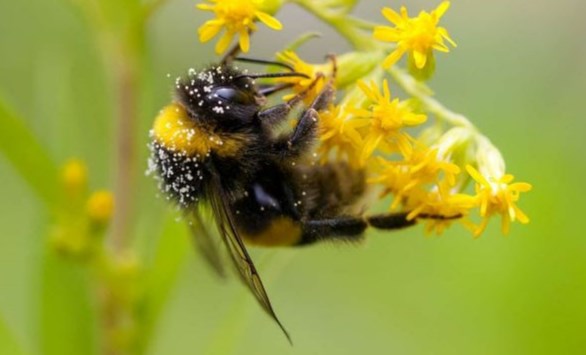The amount of land needed to support wild bees is up three and a half times greater than currently recommended, according to a study from the University of Guelph.
Amid controversy over the provincial government's proposal to utilize protected Greenbelt land for housing developments, the study by University of Guelph and Cape Breton University scientists says recommendations for wild bee habitats "fall short of what these critical food crop pollinators need."
Pollinators provide an essential ecosystem service. One of the major groups of pollinating organisms are bees, which travel from flower to flower, collecting pollen and nectar for food.
There are about 420 species of bees in Ontario.
“We have quite a diverse community of bees in the province and each of them have different habitat requirements,” said Nigel Raine, Rebanks Family Chair in Pollinator Conservation in the Ontario Agricultural College’s School of Environmental Sciences at the University of Guelph.
“The fact that we have all of this diversity is something that we were trying to capture and understand to what extent habitat and landscape might limit the ability to survive.”
Declines have been documented for several bee species attributed to various factors including habitat loss and degradation, climate change, and pesticide exposure.
Raine says different types of species, sizes and ecologies of bees all have different foraging distances.
“Typically, smaller, solitary bees forage over 10’s to 100’s of metres from where their nest sites are. Bumble bees forage over larger distances from 100’s to maybe a couple kilometres. Honeybees tend to forage over more extensive areas of the landscape,” Raine said.
“To conserve wild bees and the pollination services they provide to us, we need to know the extent of the habitat required to sustain the species.”
The study, published in Scientific Reports, is the first to evaluate how much land is required to maintain communities of wild native bees in Canada.
The results show that safeguarding healthy wild bee communities requires 11.6 to 16.7 per cent land cover from a range of habitat types in a landscape.
That range is 2.6 to 3.7 times greater than the 2.5-per-cent land cover recommendations currently proposed.
According to Raine, failing to meet these targets will worsen the global biodiversity crisis.
“We know that habitat loss and habitat fragmentation are key drivers for pollinator decline and that includes wild bees. Fundamentally, if they don’t have enough space, they don’t have enough to find the flowers needed for nectar and pollen, and places they need to rest and produce their offspring,” Raine said.
For the study, researchers combined extensive collection records of Canadian wild bees with high-resolution habitat maps to determine how much land is required.
“There are other environmental stress factors. We know that exposure and risk of pesticides may be substantially higher. We know that climate change is a problem for pollinators. With less habitat, there may be more nutritional stress for those bees as they struggle to get the food that they need to be healthy,” Raine said.
The team’s results provide targeted recommendations for action to conserve these essential pollinators.
“We know that wild bees and other insect pollinators are critical in supporting a wide range of plants and non crop plants, around 85 per cent of flowering plant species rely on, to some extent, on the services of pollinators. All terrestrial ecosystems are really dependant on pollination services,” Raine said.
Raine says everyone needs to think about biodiversity, and that pollinators play a key part in that.
“It’s in everyone’s interest to support pollinator communities so that we can provide and produce food sustainably, economically and environmentally," he said.
The goals outlined in the study pertain to the design and management of landscapes, whether it's a farm, an urban or natural landscape, a backyard, park or community space.
"This is something that we all need to work towards," Raine said.
In 2016, the Ontario government produced an Action Plan to Protect Pollinators.
“One of the pillars of that was the aspiration to restore and protect 1 million acres of habitat,” Raine said.
“Obviously, that sounds very impressive. And we thought, well is that enough? Is that a lot? But when you look at the area of southern Ontario, it’s only about four and a half per cent of the land area."
Raine says that aspiration target of four and a half per cent is substantially less than the levels that are actually required.
“We need to find more space for biodiversity in all of these landscapes. That can be done in an individual level. Think about what you are planting in your garden. Think about places where you can have nesting sites or other sites for ground nesting bees. We know that they are very important and very diverse,” Raine said.
“We need to think about how we can protect key sensitive habitats such as tallgrass prairie or tall grass woodland. And wetlands are really important in supporting bees as well."
Farmers rely on pollinators to grow fruits and vegetables.
Raine says If farmers don’t have pollinators, they must then rely on hiring honeybee keepers to help with pollination.
“One in every three bites of food we take is the direct result of pollinators,” Raine said.
“Conserving insufficient habitat will directly impact pollination services and, ultimately, food security on a national and international scale.”



